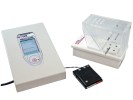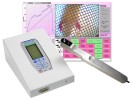Authors
VA Palikov, YA Palikova, NA Borozdina et al
Lab
Branch of the Shemyakin-Ovchinnikov Institute of Bioorganic Chemistry, Russian Academy of Sciences, Prospekt Nauki, Pushchino, Russia
Journal
Research Results in Pharmacology
Abstract
Introduction The article presents the results of the functional tests to improve the assessment of MIA-induced osteo-arthritis development and the effectiveness of NSAID therapy.
Materials and methods In the study, 26 male SD rats were used. MIA-induced osteoarthritis was simulated in the right knee joint. After an intra-articular injection of MIA, the animals were treated with ibuprofen and meloxicam. Pain assessment was studied in the following functional tests: incapacitance (hind limb weight bearing) test, von Frey test (mechanical allodynia), grip strength test, and knee diameter measurement. At the end of the study, a histological analysis of the knee joint was performed.
Results and discussion An intra-articular MIA injection reduced 1.5 times the paw withdrawal threshold. In the rats that suffered MIA-induced osteoarthritis, the difference between the diameters of the intact and injected joints was 1.05 mm, compared to 0.03 mm difference in the control group. Hind limb weight bearing asymmetry was 89.5% when simulating MIA-induced osteoarthritis. The muscular hind limb grip strength in rats with MIA-induced osteoarthritis was significantly reduced on 3rd and 7th days after simulating osteoarthritis. Ibuprofen and meloxicam showed significant efficacy in all the above tests, although ibuprofen effectiveness was more pronounced than that of meloxicam.
Conclusion The following functional tests were identified as the most significant and sufficient to assess the devel-opment of MIA-induced osteoarthritis and analgesic efficacy of NSAIDs: incapacitance test, allodynia test (von Frey filaments), measurement of hind limb grip strength and measurement of the diameter of the inflamed knee joint. The histological analysis made it possible to confirm the correspondence of the physiological response and pathological changes in the knee joint.

 Pain - Thermal Allodynia / Hyperalgesia
Pain - Thermal Allodynia / Hyperalgesia Pain - Spontaneous Pain - Postural Deficit
Pain - Spontaneous Pain - Postural Deficit Pain - Mechanical Allodynia / Hyperalgesia
Pain - Mechanical Allodynia / Hyperalgesia Learning/Memory - Attention - Addiction
Learning/Memory - Attention - Addiction Physiology & Respiratory Research
Physiology & Respiratory Research
 Pain
Pain Central Nervous System (CNS)
Central Nervous System (CNS) Neurodegeneration
Neurodegeneration Sensory system
Sensory system Motor control
Motor control Mood Disorders
Mood Disorders Other disorders
Other disorders Muscular system
Muscular system Joints
Joints Metabolism
Metabolism Cross-disciplinary subjects
Cross-disciplinary subjects Preclinical studies and opioids: role in crisis management in the United States
Preclinical studies and opioids: role in crisis management in the United States 

